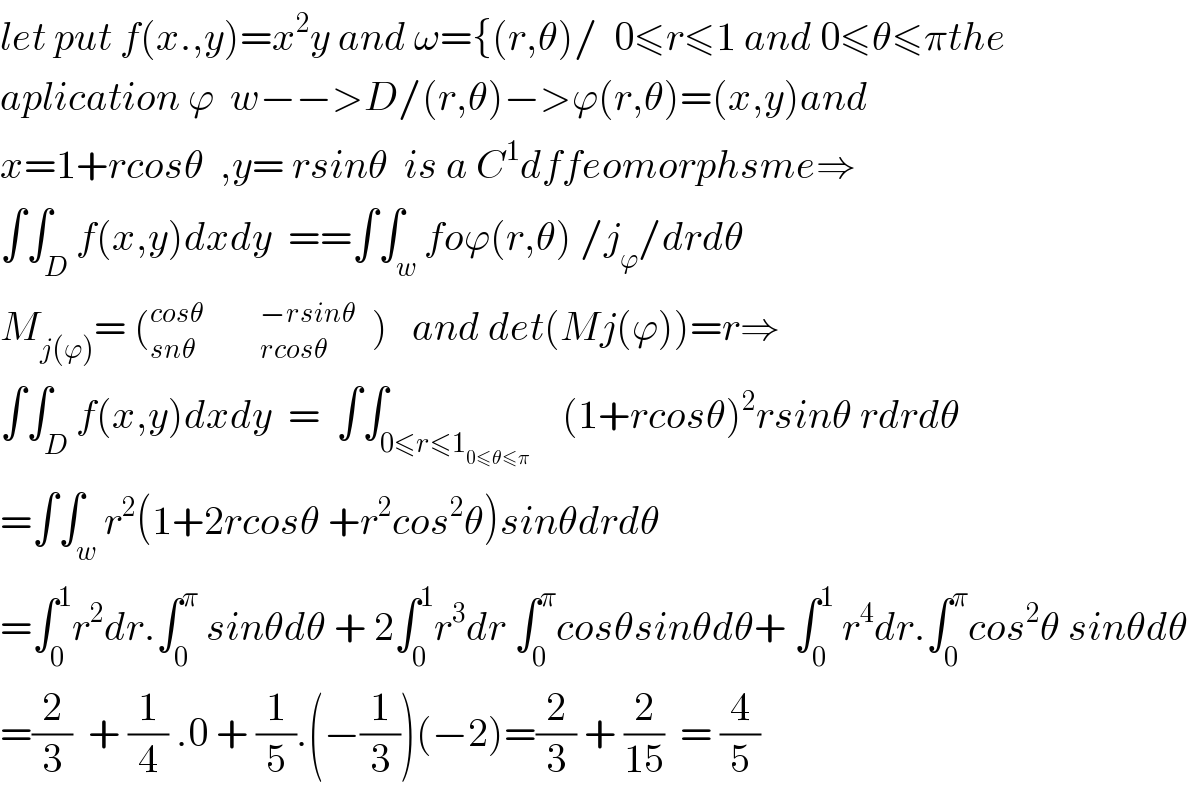
Question Number 26398 by abdo imad last updated on 25/Dec/17

$${find}\:{the}\:{value}\:{of}\:\:\int\int_{{D}} \:{x}^{\mathrm{2}} {y}\:{dxdy}\:\:\:{on}\:{the}\:{domain} \\ $$$${D}=\left\{\left({x}.{y}\right)\in{R}^{\mathrm{2}} /\:{x}^{\mathrm{2}} \:+{y}^{\mathrm{2}} \:−\mathrm{2}{x}\leqslant\mathrm{0}\:{and}\:{y}\geqslant\mathrm{0}\right\} \\ $$
Commented by abdo imad last updated on 25/Dec/17

$${let}\:{put}\:{f}\left({x}.,{y}\right)={x}^{\mathrm{2}} {y}\:{and}\:\omega=\left\{\left({r},\theta\right)/\:\:\mathrm{0}\leqslant{r}\leqslant\mathrm{1}\:{and}\:\mathrm{0}\leqslant\theta\leqslant\pi{the}\right. \\ $$$${aplication}\:\varphi\:\:{w}−−>{D}/\left({r},\theta\right)−>\varphi\left({r},\theta\right)=\left({x},{y}\right){and} \\ $$$${x}=\mathrm{1}+{rcos}\theta\:\:,{y}=\:{rsin}\theta\:\:{is}\:{a}\:{C}^{\mathrm{1}} {dffeomorphsme}\Rightarrow \\ $$$$\int\int_{{D}} {f}\left({x},{y}\right){dxdy}\:\:==\int\int_{{w}} {fo}\varphi\left({r},\theta\right)\:/{j}_{\varphi} /{drd}\theta \\ $$$${M}_{{j}\left(\varphi\right)} =\:\left(_{{sn}\theta\:\:\:\:\:\:\:\:\:\:\:\:\:\:\:\:{rcos}\theta} ^{{cos}\theta\:\:\:\:\:\:\:\:\:\:\:\:\:\:−{rsin}\theta} \:\:\right)\:\:\:{and}\:{det}\left({Mj}\left(\varphi\right)\right)={r}\Rightarrow \\ $$$$\int\int_{{D}} {f}\left({x},{y}\right){dxdy}\:\:=\:\:\int\int_{\mathrm{0}\leqslant{r}\leqslant\mathrm{1}_{\mathrm{0}\leqslant\theta\leqslant\pi} } \:\:\:\left(\mathrm{1}+{rcos}\theta\right)^{\mathrm{2}} {rsin}\theta\:{rdrd}\theta \\ $$$$=\int\int_{{w}} {r}^{\mathrm{2}} \left(\mathrm{1}+\mathrm{2}{rcos}\theta\:+{r}^{\mathrm{2}} {cos}^{\mathrm{2}} \theta\right){sin}\theta{drd}\theta \\ $$$$=\int_{\mathrm{0}} ^{\mathrm{1}} {r}^{\mathrm{2}} {dr}.\int_{\mathrm{0}} ^{\pi} \:{sin}\theta{d}\theta\:+\:\mathrm{2}\int_{\mathrm{0}} ^{\mathrm{1}} {r}^{\mathrm{3}} {dr}\:\int_{\mathrm{0}} ^{\pi} {cos}\theta{sin}\theta{d}\theta+\:\int_{\mathrm{0}} ^{\mathrm{1}} \:{r}^{\mathrm{4}} {dr}.\int_{\mathrm{0}} ^{\pi} {cos}^{\mathrm{2}} \theta\:{sin}\theta{d}\theta \\ $$$$=\frac{\mathrm{2}}{\mathrm{3}}\:\:+\:\frac{\mathrm{1}}{\mathrm{4}}\:.\mathrm{0}\:+\:\frac{\mathrm{1}}{\mathrm{5}}.\left(−\frac{\mathrm{1}}{\mathrm{3}}\right)\left(−\mathrm{2}\right)=\frac{\mathrm{2}}{\mathrm{3}}\:+\:\frac{\mathrm{2}}{\mathrm{15}}\:\:=\:\frac{\mathrm{4}}{\mathrm{5}} \\ $$
Commented by ajfour last updated on 25/Dec/17

Answered by kaivan.ahmadi last updated on 25/Dec/17

Commented by prakash jain last updated on 25/Dec/17
if you CamScanner app image will be cleaner https://play.google.com/store/apps/details?id=com.intsig.camscanner
Answered by ajfour last updated on 25/Dec/17
![x=rcos θ , y=rsin θ , r_(max) =2cos θ_(max) dxdy=(rdr)dθ ∫∫_D (x^2 y)(dxdy) =∫_0 ^( π/2) ∫_0 ^(2cos θ_(max) ) (r^3 cos^2 θsin θ)(rdrdθ) =∫_0 ^( π/2) [∫_0 ^(2cos θ_(max) ) (r^4 dr)]cos^2 θsin θdθ =∫_0 ^( π/2) (((2cos θ)^5 cos^2 θsin θ)/5)dθ =((32)/5)×(((cos θ)^8 )/8)∣_(π/2) ^0 =(4/5) .](Q26432.png)
$${x}={r}\mathrm{cos}\:\theta\:\:,\:\:{y}={r}\mathrm{sin}\:\theta\:,\:{r}_{{max}} =\mathrm{2cos}\:\theta_{{max}} \\ $$$${dxdy}=\left({rdr}\right){d}\theta \\ $$$$\int\int_{{D}} \left({x}^{\mathrm{2}} {y}\right)\left({dxdy}\right) \\ $$$$=\int_{\mathrm{0}} ^{\:\:\pi/\mathrm{2}} \int_{\mathrm{0}} ^{\mathrm{2cos}\:\theta_{{max}} } \left({r}^{\mathrm{3}} \mathrm{cos}\:^{\mathrm{2}} \theta\mathrm{sin}\:\theta\right)\left({rdrd}\theta\right) \\ $$$$=\int_{\mathrm{0}} ^{\:\:\pi/\mathrm{2}} \left[\int_{\mathrm{0}} ^{\mathrm{2cos}\:\theta_{{max}} } \left({r}^{\mathrm{4}} {dr}\right)\right]\mathrm{cos}\:^{\mathrm{2}} \theta\mathrm{sin}\:\theta{d}\theta \\ $$$$=\int_{\mathrm{0}} ^{\:\pi/\mathrm{2}} \frac{\left(\mathrm{2cos}\:\theta\right)^{\mathrm{5}} \mathrm{cos}\:^{\mathrm{2}} \theta\mathrm{sin}\:\theta}{\mathrm{5}}{d}\theta \\ $$$$=\frac{\mathrm{32}}{\mathrm{5}}×\frac{\left(\mathrm{cos}\:\theta\right)^{\mathrm{8}} }{\mathrm{8}}\mid_{\pi/\mathrm{2}} ^{\mathrm{0}} \:=\frac{\mathrm{4}}{\mathrm{5}}\:. \\ $$
